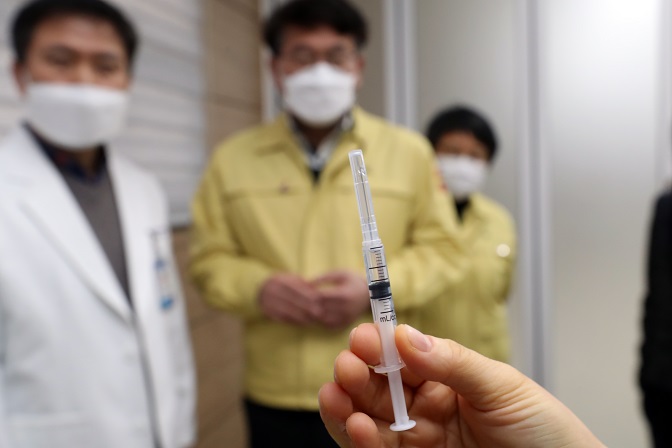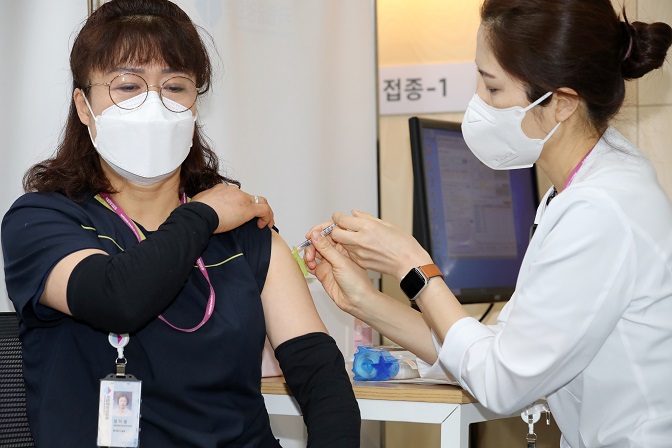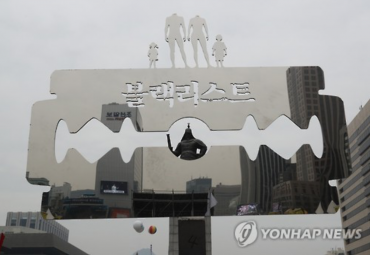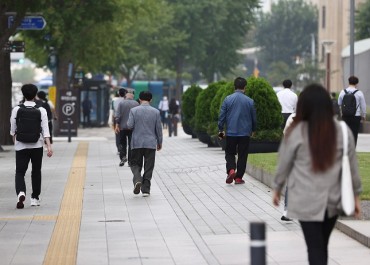
A medical worker holds up a shot containing AstraZeneca’s COVID-19 vaccine at a hospital in Gwangju, 330 kilometers south of Seoul, on Feb. 27, 2021. (Yonhap)
SEOUL, Feb. 27 (Korea Bizwire) – South Korea’s daily new coronavirus cases stayed above 400 on Saturday, the second day of mass vaccinations, as sporadic cluster infections continued to linger throughout the nation.
The country reported 415 more virus cases, including 405 local infections, raising the total caseload to 89,321, according to the Korea Disease Control and Prevention Agency (KDCA).
Saturday’s daily caseload marks a rise from 406 tallied the previous day. The figure reached a weekly low of 332 on Monday, before gradually increasing throughout the week with some ups and downs amid the nationwide cluster infections.
There were 10 more deaths from COVID-19, raising the total to 1,595. The fatality rate was 1.79 percent.
On Friday, South Korea launched its first vaccination campaign starting with health care workers and patients at nursing facilities and hospitals across the nation with the vaccine developed by AstraZeneca.
The AstraZeneca vaccine is deemed more convenient for mass inoculations as its storage temperature is 2 to 8 C, compared with the vaccine by U.S. pharmaceutical giant Pfizer Inc. that requires ultra-cold chain storage.
Medical workers at hospitals for virus patients started receiving the Pfizer vaccine Saturday as well. They are the first batch of vaccines acquired through the World Health Organization’s global vaccine COVAX Facility project.
South Korea plans to obtain herd immunity by November.
The KDCA said it has identified 15 cases of abnormal reactions from the AstraZeneca vaccine, although all of them were minor symptoms, such as headaches. No such cases were reported among recipients of Pfizer jabs.
“Tens of millions of people have received vaccines from AstraZeneca and Pfizer overseas, and their safety and effectiveness have already been proven through the process,” Kwon Joon-wook, deputy director of the Central Disease Control Headquarters, said during a daily briefing.
Authorities also plan to roll out investigations on those who have received the vaccination to keep track of the ratio of people with antibodies against COVID-19.
South Korea, meanwhile, said it has succeeded in vaccinating one more recipient per bottle of Pfizer’s vaccine that contains six doses.
The breakthrough was made possible by utilizing “low dead space” syringes designed to minimize wasted vaccine doses.
The number of jabs that can be provided per bottle of AstraZeneca’s vaccine also increased to 11 or 12 from the previous 10 through the method.
The exact number of recipients per bottle, however, will also depend on the skill of medical workers, they added.

A worker at the National Medical Center in central Seoul receives the first local shot of Pfizer’s COVID-19 vaccine on Feb. 27, 2021. (Yonhap)
The country, meanwhile, decided to keep the current level of social distancing for another two weeks through March 14. The guideline was originally planned to run through Sunday.
The capital area, home to around half of the nation’s 52-million population, is currently under Level 2 distancing, which is the third highest in the five-tier virus curbs.
Restaurants and bars in the capital area are allowed to remain open for an hour longer until 10 p.m.
Bans on gatherings of five or more people, however, are still in place nationwide.
Next week, a draft of a new social distancing system will be unveiled. The government will receive public opinions on the plan before finalizing it.
Of the 405 locally transmitted cases, 130 cases were reported in Seoul and 166 in the surrounding Gyeonggi Province. Incheon, 40 kilometers west of the capital city, added 27 more cases.
Cluster infections lingered nationwide, with a hospital in central Seoul reporting eight more cases, raising the caseload to 257.
Another private gathering from the capital city identified four more COVID-19 cases, with the total reaching 85.
A boiler factory in Asan, South Chungcheong Province, added six more patients, raising the tally to 198.
Over the past two weeks, 30.6 percent of the newly added patients were traced to cluster infections, with the transmission routes of 21 percent remaining unknown.
There were 10 more cases from overseas, raising the caseload to 7,024.
The United States accounted for three cases, followed by Indonesia with two.
The number of seriously or critically ill COVID-19 patients came to 142, down two from the previous day.
The total number of people released from quarantine after making full recoveries was 80,333, up 453 from a day earlier. This indicates nearly 90 percent of COVID-19 patients reported here have been cured.
South Korea has carried out 6,627,215 COVID-19 tests so far, including 37,149 from the previous day.
The KCDA added 18,489 people across the country got their first shots of the two-dose AstraZeneca vaccine as of Friday.
(Yonhap)






